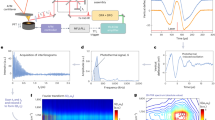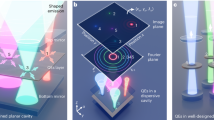Abstract
Thermally excited electrons and holes form a quantum-critical Dirac fluid in ultraclean graphene and their electrodynamic responses are described by a universal hydrodynamic theory. The hydrodynamic Dirac fluid can host intriguing collective excitations distinctively different from those in a Fermi liquid1,2,3,4. Here we report the observation of the hydrodynamic plasmon and energy wave in ultraclean graphene. We use the on-chip terahertz (THz) spectroscopy technique to measure the THz absorption spectra of a graphene microribbon as well as the propagation of the energy wave in graphene close to charge neutrality. We observe a prominent high-frequency hydrodynamic bipolar-plasmon resonance and a weaker low-frequency energy-wave resonance of the Dirac fluid in ultraclean graphene. The hydrodynamic bipolar plasmon is characterized by the antiphase oscillation of massless electrons and holes in graphene. The hydrodynamic energy wave is an electron-hole sound mode with both charge carriers oscillating in phase and moving together. The spatial–temporal imaging technique shows that the energy wave propagates at a characteristic speed of \({V}_{{\rm{F}}}/\sqrt{{\rm{2}}}\) near the charge neutrality2,3,4. Our observations open new opportunities to explore collective hydrodynamic excitations in graphene systems.
This is a preview of subscription content, access via your institution
Access options
Access Nature and 54 other Nature Portfolio journals
Get Nature+, our best-value online-access subscription
$29.99 / 30 days
cancel any time
Subscribe to this journal
Receive 51 print issues and online access
$199.00 per year
only $3.90 per issue
Buy this article
- Purchase on Springer Link
- Instant access to full article PDF
Prices may be subject to local taxes which are calculated during checkout





Similar content being viewed by others
Data availability
The data that support the findings of this study are available from the corresponding author on request. Source data are provided with this paper.
References
Sun, Z., Basov, D. N. & Fogler, M. M. Universal linear and nonlinear electrodynamics of a Dirac fluid. Proc. Natl Acad. Sci. USA 115, 3285–3289 (2018).
Lucas, A. & Fong, K. C. Hydrodynamics of electrons in graphene. J. Phys. Condens. Matter 30, 053001 (2018).
Briskot, U. et al. Collision-dominated nonlinear hydrodynamics in graphene. Phys. Rev. B 92, 115426 (2015).
Phan, T. V., Song, J. C. W. & Levitov, L. S. Ballistic heat transfer and energy waves in an electron system. Preprint at https://arxiv.org/abs/1306.4972 (2013).
Geim, A. K. & Novoselov, K. S. in Nanoscience and Technology: A Collection of Reviews from Nature Journals 11–19 (World Scientific, 2010).
Levitov, L., Shtyk, A. & Feigelman, M. Electron-electron interactions and plasmon dispersion in graphene. Phys. Rev. B 88, 235403 (2013).
Torre, I. et al. Acoustic plasmons at the crossover between the collisionless and hydrodynamic regimes in two-dimensional electron liquids. Phys. Rev. B 99, 144307 (2019).
Narozhny, B., Gornyi, I. & Titov, M. Hydrodynamic collective modes in graphene. Phys. Rev. B 103, 115402 (2021).
Sun, Z., Basov, D. & Fogler, M. Adiabatic amplification of plasmons and demons in 2D systems. Phys. Rev. Lett. 117, 076805 (2016).
Moll, P. J., Kushwaha, P., Nandi, N., Schmidt, B. & Mackenzie, A. P. Evidence for hydrodynamic electron flow in PdCoO2. Science 351, 1061–1064 (2016).
Ku, M. J. et al. Imaging viscous flow of the Dirac fluid in graphene. Nature 583, 537–541 (2020).
Bandurin, D. A. et al. Fluidity onset in graphene. Nat. Commun. 9, 4533 (2018).
Bandurin, D. et al. Negative local resistance caused by viscous electron backflow in graphene. Science 351, 1055–1058 (2016).
Berdyugin, A. I. et al. Measuring Hall viscosity of graphene’s electron fluid. Science 364, 162–165 (2019).
Krishna Kumar, R. et al. Superballistic flow of viscous electron fluid through graphene constrictions. Nat. Phys. 13, 1182–1185 (2017).
Jenkins, A. et al. Imaging the breakdown of ohmic transport in graphene. Phys. Rev. Lett. 129, 087701 (2022).
Crossno, J. et al. Observation of the Dirac fluid and the breakdown of the Wiedemann-Franz law in graphene. Science 351, 1058–1061 (2016).
Gallagher, P. et al. Quantum-critical conductivity of the Dirac fluid in graphene. Science 364, 158–162 (2019).
Narozhny, B. N. Electronic hydrodynamics in graphene. Ann. Phys. 411, 167979 (2019).
Lucas, A. & Sarma, S. D. Electronic sound modes and plasmons in hydrodynamic two-dimensional metals. Phys. Rev. B 97, 115449 (2018).
Kiselev, E. I. & Schmalian, J. Nonlocal hydrodynamic transport and collective excitations in Dirac fluids. Phys. Rev. B 102, 245434 (2020).
Lucas, A. Sound waves and resonances in electron-hole plasma. Phys. Rev. B 93, 245153 (2016).
Dufty, J., Luo, K. & Wrighton, J. Generalized hydrodynamics revisited. Phys. Rev. Res. 2, 023036 (2020).
Svintsov, D. Hydrodynamic-to-ballistic crossover in Dirac materials. Phys. Rev. B 97, 121405 (2018).
Fateev, D. & Popov, V. Hydrodynamic terahertz plasmons and electron sound in graphene with spatial dispersion. Semiconductors 54, 941–945 (2020).
Svintsov, D., Vyurkov, V., Yurchenko, S., Otsuji, T. & Ryzhii, V. Hydrodynamic model for electron-hole plasma in graphene. J. Appl. Phys. 111, 083715 (2012).
Anderson, L. et al. The clustering of galaxies in the SDSS-III Baryon Oscillation Spectroscopic Survey: baryon acoustic oscillations in the Data Releases 10 and 11 Galaxy samples. Mon. Not. R. Astron. Soc. 441, 24–62 (2014).
Woessner, A. et al. Highly confined low-loss plasmons in graphene–boron nitride heterostructures. Nat. Mater. 14, 421–425 (2015).
Ni, G. et al. Fundamental limits to graphene plasmonics. Nature 557, 530–533 (2018).
Müller, M., Fritz, L. & Sachdev, S. Quantum-critical relativistic magnetotransport in graphene. Phys. Rev. B 78, 115406 (2008).
Gierz, I. et al. Snapshots of non-equilibrium Dirac carrier distributions in graphene. Nat. Mater. 12, 1119–1124 (2013).
George, P. A. et al. Ultrafast optical-pump terahertz-probe spectroscopy of the carrier relaxation and recombination dynamics in epitaxial graphene. Nano Lett. 8, 4248–4251 (2008).
Yan, H. et al. Time-resolved Raman spectroscopy of optical phonons in graphite: phonon anharmonic coupling and anomalous stiffening. Phys. Rev. B 80, 121403 (2009).
Kang, K., Abdula, D., Cahill, D. G. & Shim, M. Lifetimes of optical phonons in graphene and graphite by time-resolved incoherent anti-Stokes Raman scattering. Phys. Rev. B 81, 165405 (2010).
Strait, J. H. et al. Very slow cooling dynamics of photoexcited carriers in graphene observed by optical-pump terahertz-probe spectroscopy. Nano Lett. 11, 4902–4906 (2011).
Graham, M. W., Shi, S.-F., Ralph, D. C., Park, J. & McEuen, P. L. Photocurrent measurements of supercollision cooling in graphene. Nat. Phys. 9, 103–108 (2013).
Song, J. C. & Levitov, L. S. Energy flows in graphene: hot carrier dynamics and cooling. J. Phys. Condens. Matter 27, 164201 (2015).
Mics, Z. et al. Thermodynamic picture of ultrafast charge transport in graphene. Nature 6, 7655 (2015).
Tielrooij, K.-J. et al. Photoexcitation cascade and multiple hot-carrier generation in graphene. Nature 9, 248–252 (2013).
Schneider, J. B. Understanding the finite-difference time-domain method. https://eecs.wsu.edu/~schneidj/ufdtd/ (2010).
Bao, W. et al. Mapping local charge recombination heterogeneity by multidimensional nanospectroscopic imaging. Science 338, 1317–1321 (2012).
Acknowledgements
The on-chip terahertz spectroscopy and theoretical analysis of the work was supported by the US Department of Energy, Office of Science, Office of Basic Energy Sciences, Materials Sciences and Engineering Division under contract number DE-AC02-05CH11231 within the vdW heterostructure Program (KCWF16). The device fabrication is supported by the Army Research Office award W911NF2110176. S.C. acknowledges support from Kavli ENSI Heising-Simons Junior Fellowship. K.W. and T.T. acknowledge support from the Element Strategy Initiative conducted by the MEXT, Japan and the CREST (JPMJCR15F3), JST.
Author information
Authors and Affiliations
Contributions
F.W. conceived the research. W.Z. carried out the on-chip THz measurements. S.W. and Z.Z. fabricated the graphene devices. W.Z., S.W., S.C. and F.W. performed the data analysis. K.W. and T.T. grew the hBN crystals. F.W., W.Z., S.C. and A.Z. wrote the manuscript.
Corresponding author
Ethics declarations
Competing interests
The authors declare no competing interests.
Peer review
Peer review information
Nature thanks Dmitry Svintsov and the other, anonymous, reviewer(s) for their contribution to the peer review of this work.
Additional information
Publisher’s note Springer Nature remains neutral with regard to jurisdictional claims in published maps and institutional affiliations.
Extended data figures and tables
Extended Data Fig. 1 On-chip THz spectroscopy on graphene microribbon.
a, Optical micrograph of the device close to the sample region. b, Cross-sectional schematics of the sample under study. The graphene microribbon of 2 μm width and 20 μm length is encapsulated by hBN flakes. The doping level of the microribbon is controlled through a few-layer MoS2 back gate for its minimal absorption in the THz frequency range. c, Illustration of the collective motion of electrons and holes in hydrodynamic bipolar plasmon and demon.
Extended Data Fig. 2 Optical micrograph of the graphene microribbon device for hydrodynamic plasmon and demon measurements.
The waveguide consists of two parallel gold traces of 20 μm width separated by a 15-μm gap. The gap is tapered and narrowed down near the sample to enhance the sample–waveguide coupling.
Extended Data Fig. 3 Temperature difference of the absorption spectra, \({{\boldsymbol{A}}}_{{{\boldsymbol{V}}}_{{\bf{G}}},{{\boldsymbol{T}}}_{{\bf{e}}}}\,-{{\boldsymbol{A}}}_{{{\boldsymbol{V}}}_{{\bf{G}}},{{\boldsymbol{T}}}_{{\bf{0}}}}\), obtained by the double-modulation measurement.
The absorption shows a symmetric profile with respect to VG = −0.1 V, the back-gate voltage associated with the charge-neutrality point.
Extended Data Fig. 4 Determination of ACNP and background subtraction for the absorption spectra.
a, The measured spectrum (solid curve) is fitted to a two-Lorentzian model, in which L1 and L2 represent the fitted absorption spectra at the charge-neutrality point and VG, respectively. b, The global background absorption spectra obtained by averaging the fitted ACNP over a broad range of gate voltages from 0.1 V to 0.8 V. c, Measured \({{A}_{{V}_{{\rm{G}}}}-A}_{{\rm{CNP}}}\) at various gate voltages. d, \({A}_{{V}_{{\rm{G}}}}\) obtained by subtracting the global absorption background associated with ACNP.
Extended Data Fig. 5 Field response of the nanogap.
Schematic top view (a) and side view (b) of the model used in the FDTD simulations. c, Field amplitude collected at the monitor position. d, Linecut of the field amplitude at 0.1 THz.
Extended Data Fig. 6 Linear fit of the phase term along the propagation direction for different carrier densities.
From top to bottom, the frequency changes from 0.03 THz to 0.1 THz. q(f) corresponds to the phase-accumulation slope.
Extended Data Fig. 7 Exponential fit of the amplitude decay, q′(f), along the propagation direction at different carrier densities.
The y axis is plotted in logarithmic scale.
Supplementary information
Supplementary Information
This file contains Supplementary Figures 1–6 and Supplementary References.
Rights and permissions
Springer Nature or its licensor (e.g. a society or other partner) holds exclusive rights to this article under a publishing agreement with the author(s) or other rightsholder(s); author self-archiving of the accepted manuscript version of this article is solely governed by the terms of such publishing agreement and applicable law.
About this article
Cite this article
Zhao, W., Wang, S., Chen, S. et al. Observation of hydrodynamic plasmons and energy waves in graphene. Nature 614, 688–693 (2023). https://doi.org/10.1038/s41586-022-05619-8
Received:
Accepted:
Published:
Issue Date:
DOI: https://doi.org/10.1038/s41586-022-05619-8
Comments
By submitting a comment you agree to abide by our Terms and Community Guidelines. If you find something abusive or that does not comply with our terms or guidelines please flag it as inappropriate.



